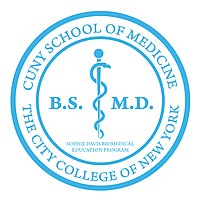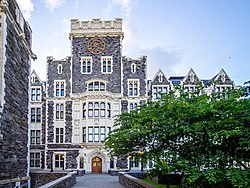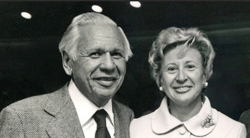CUNY School of Medicine
This article needs additional citations for verification. (November 2018) |
| Type | Public medical school |
|---|---|
| Established | June 10, 2015 |
| Dean | Carmen Renée Green |
Academic staff | 117 |
| Students | 400 |
| Location | , New York , USA 40°49′10″N 73°57′00″W / 40.8194°N 73.9500°W |
| Campus | Urban |
| Colors | Sky Blue |
| Affiliations | The City College of New York |
| Website | cunymed |
 | |

The City University of New York (CUNY) School of Medicine is a public medical school that was established on June 10, 2015, and began operation in the fall of 2016. The school is in Hamilton Heights on the campus of The City College of New York (CCNY) and partners with Saint Barnabas Health System in the South Bronx, Harlem Hospital Center of NYC Health + Hospitals Corporation, and Staten Island University Hospital of Northwell Health for clinical medical education.[1]
Currently, the primary pathway of admission to the CUNY School of Medicine is through a seven-year B.S./M.D. curriculum offered as part of the Sophie Davis Biomedical Education Program at The City College of New York. The program integrates a baccalaureate education with preclinical medical education. Admission to the school is highly selective, with an acceptance rate of around 4%, rivaling the Ivy League.
History
The origin of the CUNY School of Medicine dates back to 1973 when the Sophie Davis School of Biomedical Education was established. Named after Sophie Kesner, the wife of CCNY graduate and major benefactor Leonard Davis, the school was established to address the growing need in the United States—especially in inner city areas—for primary care physicians. Sophie Davis accepted students who graduated from high schools throughout New York State and attracted talented New York City high school graduates of diverse cultural and ethnic backgrounds. Sophie Davis prioritizes students who belong to minorities, including those of African-American and Hispanic descent. It had a rigorous course curriculum where approximately 40% of graduates became primary care physicians. Those who choose not to become primary care physicians repaid the school a fee.

Students completed their undergraduate work (B.S.) and the first two years of medical school at Sophie Davis, completed the USMLE Step 1, and transferred to one of the affiliated medical schools to finish their final two years of medical school, which are primarily medical rotations, before earning their Doctor of Medicine (M.D.) degree. NYU School of Medicine, SUNY Downstate Medical Center, New York Medical College, Albany Medical College, Northeast Ohio Medical University, Dartmouth Medical School, and Stony Brook School of Medicine were match schools for Sophie Davis graduates.
In 2016, the Sophie Davis School of Biomedical Education was renamed the Sophie Davis Biomedical Education Program when it became part of the CUNY School of Medicine,[2]. Upon completion of the accelerated 3-year Sophie Davis Biomedical Education Program, students receive a Bachelor of Science degree in Biomedical Sciences from The City College of New York and are granted direct admission to the CUNY School of Medicine without the requirement to take the Medical College Admissions Test (MCAT). Upon completion of the traditional 4-year medical school curriculum, students receive the Doctor of Medicine degree. As the CUNY School of Medicine now charges medical school tuition for the graduate portion of the BS/MD program, the school no longer requires a primary care service commitment for graduates.
Mission and outcomes
The mission of the CUNY School of Medicine is to increase the number of physicians who come from underrepresented minorities in medicine, encourage its students to pursue post-graduate training in primary care, and ultimately practice medicine in a healthcare shortage area in New York State. CUNY School of Medicine statistics show that 65% of graduates practice medicine in New York (the most of any medical school in New York State). Forty-one percent of graduates practice careers in primary care, placing the CUNY School of Medicine among the top 10 medical schools in the U.S. in producing primary care physicians. Twenty-six percent of graduates practice in a healthcare shortage area in New York State. Over the past 10 years, approximately 42% of the enrolled students come from underrepresented minorities.
The CUNY School of Medicine's Residency Match Rate is as follows: 2020-100%, 2021- 98%, 2022- 98%, 2023- 100%. The average national residency match rate is 94%.
Location
The school's address is 160 Convent Ave, Harris Hall, Room 107, New York, NY 10031.
In 2003 it moved into its permanent home in Townsend Harris Hall, which had been renovated as part of CCNY's Terra Cotta Restoration Project, and to build modern teaching capabilities into its classrooms, seminar rooms, a long-distance conference room, and teaching laboratories.
Notable alumni
- Jonathan Woodson, M.D. (Class of 1977), Assistant Secretary of Defense for Health Affairs and Director of TRICARE Management Activity
- Helen Burstin, M.D. (Class of 1984) Senior Vice President for Performance Measures of The National Quality Forum
- Laurie Zephyrin, M.D. (Class of 1997), National Director for Reproductive Health, U.S. Department of Veterans Affairs
References
- ^ Najarro, Ileana (July 14, 2015). "CUNY Medical School to Open in 2016". New York Times. Retrieved October 11, 2023.
- ^ Skelding, Conor (July 14, 2015). "New CUNY School of Medicine accredited". Capital New York. Archived from the original on July 15, 2015. Retrieved July 15, 2015.
